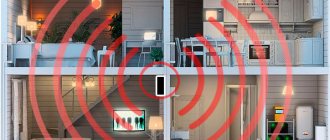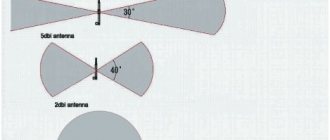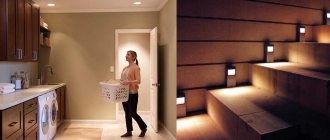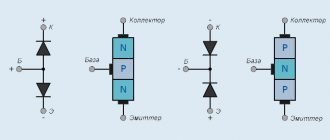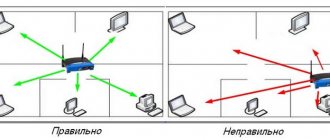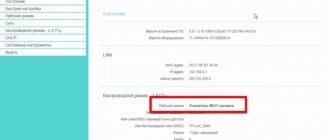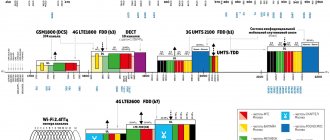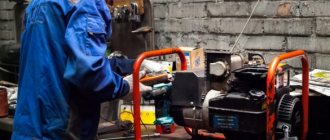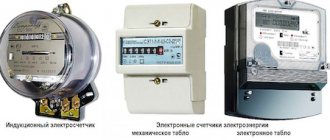A weak WiFi signal is a pressing problem for residents of apartments, country houses and office workers. Dead zones in a WiFi network are typical for both large rooms and small apartments, the area of which even a budget access point can theoretically cover.
The range of a WiFi router is a characteristic that manufacturers cannot clearly indicate on the box: the WiFi range is influenced by many factors that depend not only on the technical specifications of the device.
This material presents 10 practical tips that will help eliminate the physical causes of poor coverage and optimize the range of your WiFi router; you can easily do it yourself.
Install the antennas in a vertical position
The radiation from the access point in space is not a sphere, but a toroidal field, shaped like a donut. In order for WiFi coverage within one floor to be optimal, radio waves must propagate in a horizontal plane - parallel to the floor. For this purpose, it is possible to tilt the antennas.
The antenna is a donut axis. The angle of signal propagation depends on its inclination.
When the antenna is tilted relative to the horizon, part of the radiation is directed outside the room: dead zones are formed under the “donut” plane.
A vertically mounted antenna radiates in a horizontal plane: maximum coverage is achieved indoors.
In practice : Mounting the antenna vertically is the easiest way to optimize indoor WiFi coverage.
Purpose and capabilities of Wi-Fi antennas
The principle of operation of an external antenna is to capture radio waves emanating from a signal source and transmit them in a certain direction. The device works not only to receive, but also to send data, and is also capable of concentrating the flow of radio energy in the desired direction.
Most modern wireless Internet routers in a private home are equipped with built-in or external antennas, which are quite enough to cover the area of a small apartment.
The use of equipment is justified in the following cases:
- The room has thick concrete or reinforced concrete partitions, bulky furniture and other structures.
- It is necessary to ensure a stable signal in a certain room where the equipment is located (for example, a PC).
- To expand coverage area. For example, the best option for a summer house would be an external antenna for a router, providing Wi-Fi in the local area, in a swimming pool, bathhouse, etc.
Place the router closer to the center of the room
Another reason for the occurrence of dead zones is the poor location of the access point. The antenna emits radio waves in all directions. In this case, the radiation intensity is maximum near the router and decreases as it approaches the edge of the coverage area. If you install an access point in the center of the house, the signal will be distributed throughout the rooms more efficiently.
A router installed in a corner transmits some of the power outside the house, and distant rooms are at the edge of the coverage area.
Installation in the center of the house allows you to achieve even distribution of the signal in all rooms and minimize dead zones.
In practice: Installing an access point in the “center” of the house is not always feasible due to the complex layout, lack of sockets in the right place, or the need to lay a cable.
Homemade Wifi antenna with your own hands
It is quite possible to construct an antenna for Wifi coverage with your own hands. If all available materials are at hand, the device will cost the user much less than a purchased one.
The simplest option used to further expand the wireless zone is called the Kharchenko biquadrat. The transmitter is made of copper wire. The material is bent in the shape of a figure eight with angles of 90°. A coaxial cable is soldered to the center of the structure, on the other end of which a connector is mounted to connect to the router. The size of the antenna depends on the planned coverage and the location of the transmitter.
Another option that can often be found among Russian summer residents is a directional Wifi gun, which, according to users, is capable of spreading Wi-Fi over several kilometers. The device is a pin with strung metal disks of increasing diameter. When manufacturing a device, it is important to correctly calculate the ratio of parts, taking into account the terrain, weather conditions, the presence of interference, etc.
Provide direct visibility between the router and clients
WiFi signal frequency is 2.4 GHz. These are decimeter radio waves that do not bend well around obstacles and have low penetrating ability. Therefore, the range and stability of the signal directly depend on the number and structure of obstacles between the access point and clients.
Passing through a wall or ceiling, an electromagnetic wave loses some of its energy.
The amount of signal attenuation depends on the material the radio waves travel through.
*Effective distance is a value that determines how the radius of a wireless network changes in comparison with open space when a wave passes an obstacle.
Calculation example: WiFi 802.11n signal propagates in line-of-sight conditions over 400 meters. After overcoming the non-permanent wall between the rooms, the signal strength decreases to 400 m * 15% = 60 m. The second wall of the same type will make the signal even weaker: 60 m * 15% = 9 m. The third wall makes signal reception almost impossible: 9 m * 15 % = 1.35 m.
Such calculations will help calculate dead zones that arise due to the absorption of radio waves by walls.
The next problem in the path of radio waves: mirrors and metal structures. Unlike walls, they do not weaken, but reflect the signal, scattering it in arbitrary directions.
Mirrors and metal structures reflect and scatter the signal, creating dead zones behind them.
If you move interior elements that reflect the signal, you can eliminate dead spots.
In practice: It is extremely rare to achieve ideal conditions when all gadgets are in direct line of sight to the router. Therefore, in a real home, you will have to work separately to eliminate each dead zone:
- find out what interferes with the signal (absorption or reflection);
- think about where to move the router (or piece of furniture).
Place the router away from sources of interference
The 2.4 GHz band does not require licensing and is therefore used for the operation of household radio standards: WiFi and Bluetooth. Despite the low bandwidth, Bluetooth can still interfere with the router.
Green areas are the stream from the WiFi router. Red dots are Bluetooth data. The proximity of two radio standards in the same range causes interference, reducing the range of the wireless network.
The magnetron of a microwave oven emits in the same frequency range. The radiation intensity of this device is so high that even through the protective screen of the furnace, the magnetron radiation can “illuminate” the radio beam of the WiFi router.
Microwave oven magnetron radiation causes interference on almost all WiFi channels.
On practice:
- When using Bluetooth accessories near the router, enable the AFH parameter in the settings of the latter.
- The microwave is a powerful source of interference, but it is not used very often. Therefore, if it is not possible to move the router, then you simply won’t be able to make a Skype call while preparing breakfast.
How many antennas are needed?
Old systems were equipped with one antenna, and, at that time, this was enough for slow Internet speeds of one or two megabits per second.
But as time passed, the speeds increased. Old network equipment simply did not meet the new requirements.
For fast Internet, Wi-Fi must be much faster. To improve performance, it was decided to add a second antenna, because one could not cope with the reception and transmission of data (SISO) at the increased speed.
Two or more
Two antennas on the router ensured simultaneous operation of both reception and transmission using MIMO technology. Accordingly, the speeds also increased - up to 144 Mbit/s.
It must be said that modern smartphone models also have two antennas.
Let's add one more
If a 3x3 MIMO or 2x3 MIMO configuration is used for data transmission, then a third antenna may be needed, which also works for reception/transmission. This supports wireless networks at 216 Mbps. If the router can work using the TurboQAM or NitroQAM protocol, then the speed can increase significantly!
What if there are four
For an ordinary apartment with an Ethernet connection via twisted pair, there is no point in additional “antennae”. Theoretically, the speed can be 100 Mbps, but in reality it is lower.
And if you use a simple telephone line using the xDSL protocol, then the real speed is generally 20–30 Mbit/s. In this case, the optimal device would be a router with either two antennas or a built-in one.
It’s another matter if the Internet is distributed via fiber optic networks. They can provide speeds of 1 Gbps and higher. Here's an opportunity:
- live broadcasts of streaming video;
- chatting in Internet;
- Online Games;
- quality TV;
- telephone.
In this case, the use of routers with four “whiskers” will be justified. Especially if there are several Internet users in the house, and everyone has different preferences.
Disable support for 802.11 B/G modes
WiFi devices of three specifications operate in the 2.4 GHz band: 802.11 b/g/n. N is the newest standard and provides greater speed and range compared to B and G.
The 802.11n (2.4 GHz) specification provides greater range than legacy B and G standards.
802.11n routers support previous WiFi standards, but the mechanics of backward compatibility are such that when a B/G device appears within the range of the N-router - for example, an old phone or a neighbor's router - the entire network is switched to B/G mode. Physically, the modulation algorithm changes, which leads to a drop in the speed and range of the router.
In practice: Switching the router to “pure 802.11n” mode will definitely have a positive effect on the quality of coverage and throughput of the wireless network.
However, B/G devices will not be able to connect via WiFi. If it is a laptop or TV, they can be easily connected to the router via Ethernet.
Recommendations for installing amplifiers
When installing equipment, observe the conditions for visibility of signal reception and transmission sources. Not only buildings and structures are taken into account, but also trees, which also jam the signal.
The size of the connection cable should be minimal, and it is advisable to avoid using a PCI card. The best option is a tightly insulated cable RG-6U. It is allowed to change the polarization of the amplifier (in case of interference on the air).
Reviews from craftsmen indicate that homemade amplifiers work no worse than factory devices. At the same time, they do not require significant material costs, and the process of their manufacture is simple and affordable.
Select the optimal WiFi channel in the settings
Almost every apartment today has a WiFi router, so the density of networks in the city is very high. Signals from neighboring access points overlap each other, draining energy from the radio path and greatly reducing its efficiency.
Neighboring networks operating at the same frequency create mutual interference, like ripples on the water.
Wireless networks operate within a range on different channels. There are 13 such channels (in Russia) and the router switches between them automatically.
To minimize interference, you need to understand which channels neighboring networks operate on and switch to a less loaded one. Detailed instructions for setting up the channel are presented here.
Congestion of WiFi channels in the entrance of a high-rise building.
In practice: Selecting the least loaded channel is an effective way to expand the coverage area, relevant for residents of an apartment building.
But in some cases there are so many networks on the air that not a single channel provides a noticeable increase in WiFi speed and range. Then it makes sense to turn to method No. 2 and place the router away from the walls bordering neighboring apartments. If this does not bring results, then you should think about switching to the 5 GHz band (method No. 10).
Adjust the router transmitter power
The power of the transmitter determines the energy of the radio path and directly affects the range of the access point: the more powerful the beam, the further it hits. But this principle is useless in the case of omnidirectional antennas of household routers: in wireless transmission, two-way data exchange occurs and not only clients must “hear” the router, but also vice versa.
Asymmetry: the router “reaches” a mobile device in a distant room, but does not receive a response from it due to the low power of the smartphone’s WiFi module. The connection is not established.
In practice: The recommended transmitter power value is 75%. It should be increased only in extreme cases: turning the power up to 100% not only does not improve the quality of the signal in distant rooms, but even worsens the stability of reception near the router, since its powerful radio stream “clogs” the weak response signal from the smartphone.
Antenna for a router: review of external remote devices
If the strength of the wireless Internet signal is not enough to uniformly and densely cover the required area, an antenna for the router will solve the problem. The device is especially useful outside the city, distributing the signal from a portable router using mobile Internet in the private sector.
Replace the standard antenna with a more powerful one
Most routers are equipped with standard antennas with a gain of 2 - 3 dBi. The antenna is a passive element of the radio system and is not capable of increasing the flow power. However, increasing the gain allows you to refocus the radio signal by changing the radiation pattern.
Antenna gain is similar to focusing a flashlight beam: a narrow beam shines further than a wide beam.
The higher the antenna gain, the further the radio signal travels. In this case, the narrower flow becomes similar not to a “donut”, but to a flat disk.
There is a large selection of antennas for routers with a universal SMA connector on the market.
Replaceable omnidirectional antenna.
Omnidirectional whip antenna.
Directional indoor antenna.
In practice: Using an antenna with high gain is an effective way to expand the coverage area, because simultaneously with the signal amplification, the sensitivity of the antenna increases, which means the router begins to “hear” remote devices. But due to the narrowing of the radio beam from the antenna, dead zones appear near the floor and ceiling.
How to choose an antenna for your home
The choice of a Wi-Fi antenna should be made based on your goals and objectives assigned to the local network. For some, a regular whip antenna installed on a table will be enough, while others will need a powerful outdoor antenna that covers not only the house, but also the garden plot. In any case, when choosing an antenna, experts recommend paying attention to the following characteristics:
- gain factor (GC). This parameter affects the signal propagation range by changing the range. It reflects the antenna's ability to concentrate the signal in a certain direction. The higher the KU, the longer the distance the information flow will be transmitted. However, it is worth remembering that as the radiation power increases in one direction, the power in other directions decreases;
As the gain increases, the directional pattern of the Wi-Fi signal changes
type of polarization (horizontal, vertical and circular). This indicator reflects the nature of wave propagation in space. Antennas with horizontal polarization are characterized by efficient penetration of radio waves through vertical obstacles and are less susceptible to interference, which is especially important in urban environments. Devices with vertical polarization are able to reflect the signal well from obstacles, thereby covering a large coverage area. With circular polarization, the signal is able to overcome both horizontal and vertical obstacles with minimal loss of power;
Many home access points and routers operate in vertical polarization by default, but if necessary, the polarization can be changed by rotating the antenna 90 °C
standards support. For proper operation of a passive amplifier in conjunction with a router, you need to choose a device that supports the same Wi-Fi standard as the router. Today, 802.11n is considered a universal standard, compatible with earlier modifications of 802.11a/b/c. By purchasing an antenna that supports 802.11n, you can be sure that it will work with almost any router. You can view the supported types of standards in the technical documentation of the router; availability of compatible connectors. When purchasing an antenna, you should check with the seller whether its plug will fit into the socket of your router. If the connectors do not match, you will have to purchase a special adapter. But do not forget that any extra element in the antenna assembly reduces the signal quality.
To quickly connect the antenna to the router, it is important that their connectors are compatible
Use signal repeaters
In rooms with complex layouts and multi-story buildings, it is effective to use repeaters - devices that repeat the signal from the main router.
Repeaters expand the WiFi network, covering the surrounding area and the upper floors of a country house.
Repeaters help deploy a wireless network in rooms with complex layouts.
The simplest solution is to use an old router as a repeater. The disadvantage of this scheme is that the throughput of the child network is half as much, since along with client data, the WDS access point aggregates the upstream flow from the upstream router.
Detailed instructions for setting up a WDS bridge are provided here.
A router in WDS mode helps expand WiFi network coverage.
Specialized repeaters do not have the problem of reducing bandwidth and are equipped with additional functionality. For example, some Asus repeater models support the roaming function.
In roaming mode, devices automatically connect to a more powerful network, and the connection is not lost when moving between access points.
In practice: No matter how complex the layout, repeaters will help you deploy a WiFi network. But any repeater is a source of interference interference. When there is free air, repeaters do their job well, but with a high density of neighboring networks, the use of repeater equipment in the 2.4 GHz band is impractical.
